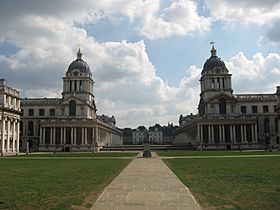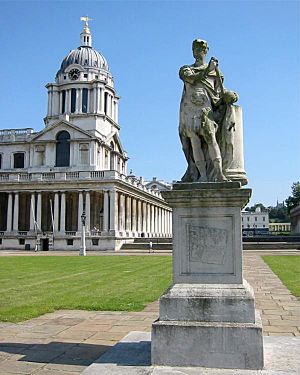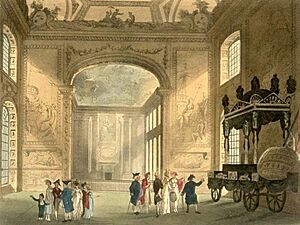Old Royal Naval College facts for kids
| UNESCO World Heritage Site | |
|---|---|

The Chapel is in Queen Mary Court (left) and the Painted Hall is in King William Court (right). The domes are above the entrances. The Queen's House is in the centre distance.
|
|
| Location | United Kingdom |
| Includes |
|
| Criteria | Cultural: (i), (ii), (iv), (vi) |
| Inscription | 1995 (19th Session) |
| Extensions | 2008 |
| Area | 109.5 hectares (271 acres) |
| Buffer zone | 174.85 hectares (432.1 acres) |
The Old Royal Naval College is a group of amazing buildings in Greenwich, London. It sits right by the River Thames. This whole area, called Maritime Greenwich, is a special World Heritage Site. This means UNESCO thinks it's super important for everyone in the world to protect.
People say it's one of the most beautiful places in the British Isles. It used to be a royal palace! Later, it became a hospital for sailors. Famous architect Christopher Wren designed many of its buildings. Today, it's a fun place for visitors and students.
Contents
A Royal Past: Greenwich Palace

Long, long ago, this spot was home to a palace called Bella Court. A duke named Humphrey built it. Later, Queen Margaret took it over and renamed it the Palace of Placentia.
King Henry VII rebuilt the palace. It became known as Greenwich Palace. Many famous Tudor monarchs were born here. These include Henry VIII, Mary I, and Elizabeth I. King Henry VIII especially loved this palace.
During the English Civil War, the palace fell apart. Most of it was torn down in 1694. Only one unfinished building remained.
Greenwich Hospital: Helping Sailors
In 1692, Queen Mary II decided to build a hospital for sailors. She saw many injured sailors returning from the Battle of La Hogue. This inspired her to create the Royal Hospital for Seamen at Greenwich.
The hospital used the remaining part of the old Greenwich Palace. Then, it grew with new buildings. The Chapel and the amazing Painted Hall were key parts. Sir James Thornhill painted the Painted Hall between 1707 and 1726.
The hospital closed its doors in 1869. In 1875, the remains of thousands of sailors were moved. They were reburied in a park nearby.
After the hospital closed, the buildings got a new purpose. In 1873, they became a training school for the Royal Navy. This school was called the Royal Naval College, Greenwich.
The Royal Navy used these buildings for many years. They finally moved out in 1998. That's when the Greenwich Foundation took over.
The Greenwich Foundation: A New Chapter
Since 1998, the Greenwich Foundation has brought the site back to life. They work to protect the old buildings and grounds. They also made it a cultural place for everyone to enjoy.
Many parts of the college are now used by students. The University of Greenwich and Trinity College of Music have campuses here. This mix creates a unique learning and cultural hub.
In 2002, the Foundation opened the entire site to visitors. You can visit the Painted Hall, the Chapel, and the grounds for free. Guided tours are also available. This means students and visitors from all over the world can explore this historic place.
Nelson's Room and More to Explore
In 2005, a special room called the Nelson Room opened. It's where Nelson's coffin was kept before his funeral. The room has a statue of Nelson and other interesting items.
You can take guided tours to see hidden parts of the college. These include old tunnels and a former bowling alley. A church service is held in the Chapel every Sunday. Public concerts and events also take place in the Painted Hall.
Today, the Old Royal Naval College is a lively spot. It has coffee shops, bars, and restaurants. It's a blend of old history and modern life in Greenwich.
Filming Location: A Star on Screen
The Old Royal Naval College is a popular place for filming! Many movies and TV shows have used its beautiful buildings.
- The Bounty
- Patriot Games
- Shanghai Knights
- Four Weddings and a Funeral
- The Madness of King George
- The Mummy Returns
- The Avengers (1998)
- Lara Croft: Tomb Raider (2001)
- Revolver (2005)
- Spooks
- Little Dorrit
- Eastern Promises
- The Golden Compass
- The Wolf Man (2009)
- Amazing Grace (2006)
- Sherlock Holmes: A Game of Shadows (2011)
- Now You See Me 2
- Pirates of the Caribbean: On Stranger Tides
- The King's Speech (it looked like Buckingham Palace!)
- The Dark Knight Rises
- Les Misérables (2012)
- Thor: The Dark World (2012)
- The Man from U.N.C.L.E. (2013)
- The Diplomat (2023–present)
The Painted Hall: A Masterpiece Restored
In 2014, the Old Royal Naval College started a big project. They wanted to restore the amazing Painted Hall. This huge painting covers 3,700 square metres (40,000 sq ft)!
The project took three years to complete. Visitors could even take special "ceiling tours." This let them see the conservators working high up on the painted ceiling. In March 2019, the hall reopened, looking more beautiful than ever. The project even won awards!
See also
 In Spanish: Old Royal Naval College para niños
In Spanish: Old Royal Naval College para niños
- Greenwich Hospital Act
- Discover Greenwich Visitor Centre



